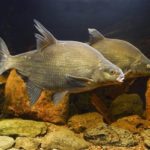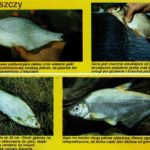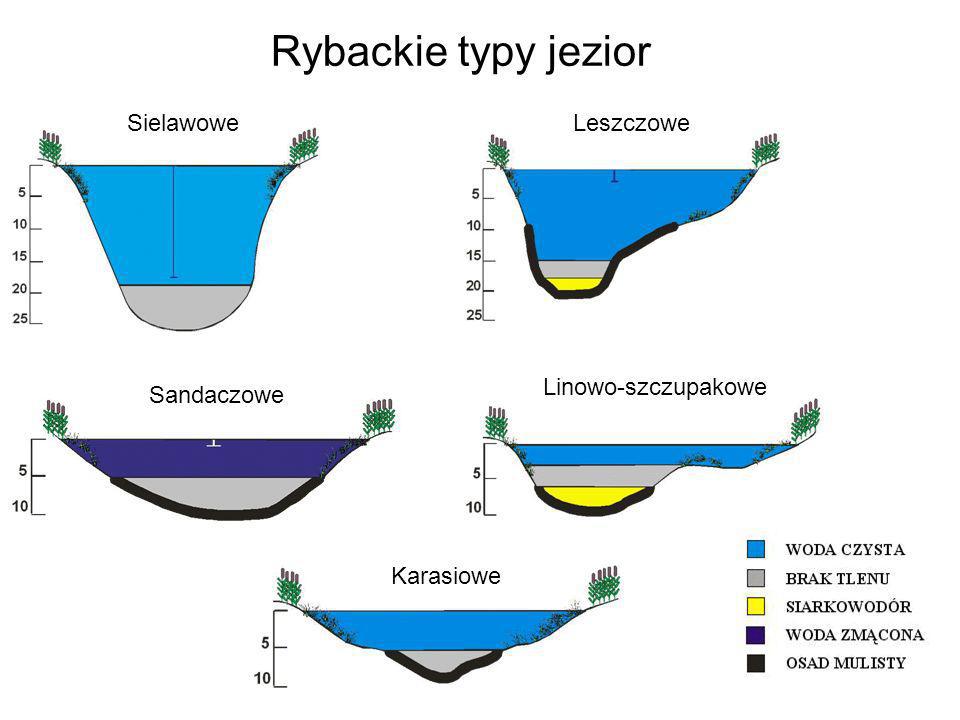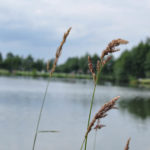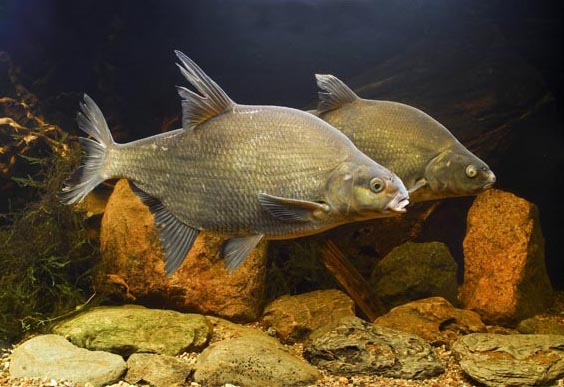
Leszcz
Przy pierwszym spotkaniu z leszczem ma się wrażenie, że on nie musi się przedstawiać. Rzeczywiście, jego specyficznie i, w porównaniu z innymi gatunkami, nietypowo ukształtowana cielesna powłoka może przypominać otwartą książkę, z której z łatwością da się wyczytać w jakim środowisku może leszcz żyć, jakiego rodzaju pożywienie lubi najbardziej, jak zyskuje pokarm, jakie są jego kwalifikacje pływackie.
Pośpiech nie bywa dobrym doradcą i przy powierzchownej ocenie leszcza, ulegając wrażeniu jego zupełnej niezgrabności czy nawet niemrawości skłonni bylibyśmy od razu wykluczyć możliwość jego obecności w wodach płynących i przypisać mu tylko wody stojące. Pochopnym wyrokiem obrazilibyśmy go jednak i bezprawnie pozbawili wielu życiowych możliwości. Wszystkie typy głębokich wód stojących, zwłaszcza te przestronniejsze, leszcz – oczywiście – uważa za swoje, równocześnie jednak wykazując swoją równość z innymi gatunkami domaga się przestrzeni życiowej także w wodach płynących. Od najbystrzejszych spadzistych odcinków cieków jednak – samokrytycznie – stroni, w nich miałby problemy z poruszaniem się; w spokojniejszym prądzie natomiast stanowczo nie da się zawstydzić i czuje się jak w domu.
Prognozy dla dalszej obecności leszcza ogólnie trzeba oceniać z optymizmem. Przemawia za tym na przykład dynamika wzrostu jego połowów, dzięki której obecnie już na stałe uplasował się na drugiej pozycji pod względem ilości łowionych egzemplarzy, tuż za karpiem. Inaczej niż karp, który zawdzięcza swoją lokatę trosce hodowców, leszcz wybił się dzięki swoim własnym zaletom.
Nadzwyczajną zaletą leszcza – obok skromności i zdolności adaptacyjnych – stanowi jego wyjątkowa zdolność do składania ikry na różnorodnych typach podłoża, na przykład na trawie, na korzeniach drzew i roślin wodnych, na delikatniejszych gałązkach, nawet na czystych skałach itp., co umożliwia mu rozmnażanie w każdym choć trochę odpowiednim środowisku, a więc w większości wód nie jest skazany na bezpośrednią pomoc hodowcy. Tarło odbywa w maju, przy niższej temperaturze dopiero w czerwcu, zawsze w liczniejszych grupach i zawsze aż manifestacyjnie „hucznie”.
W ostatecznym rozrachunku nie jest leszcz jednak tworem doskonałym – reputację skromnisia psuje mu wybredność przejawiająca się w wybieraniu przede wszystkim zwierzęcych składników pokarmu. Na dodatek do tego nałogu jego specyficznie ukształtowany, harmonijkowato wysuwany, drobny pyszczek daje mu tylko ograniczone możliwości zbierania małej objętościowo zdobyczy i to wyłącznie z dna.
Pokarm leszcza jest więc dość ubogi, zarówno ze względu na mały wybór, jak i ograniczony teren żerowania. Próby zrekompensowania związanych z harmonijkowatym pyszczkiem ograniczeń dzięki zdolności zdobywania pożywienia w głębszych warstwach mułu przynoszą tylko częściowe efekty. Podobnie jak czynione przez leszcza próby rozszerzenia sezonu przyjmowania pokarmu na cały rok, a więc także na okres łagodniejszej zimy.
W tej sytuacji bardziej pobłażliwie trzeba by oceniać małą intensywność jego wzrostu (w przeciętnych warunkach 1 kg wagi osiąga dopiero w 8.-10. roku życia). Jest prawdopodobne, że jedną z przyczyn jego powolnego wzrostu jest nadmiernie wysoka cena, jaką przychodzi mu płacić za błogie poczucie bezpieczeństwa, warunkowane przez towarzystwo licznej grupy współplemieńców. Konsekwentnie utrzymywana wspólnota rodzinna prowadzi do bezlitosnej konkurencji przy zdobywaniu pokarmu, a w skrajnych przypadkach nadmiernego rozmnożenia może doprowadzić do wzrostowej degeneracji całej populacji leszcza w niektórych typach wód. W większości wód jednak leszcz umie się odpowiednio rozsiedlić, a 4-5 kg osobniki nawet w przeciętnych warunkach można uważać za powszednie. W Niemczech np. średnia waga okazowych ryb tego gatunku wynosi 4,3 kg, w Polsce 3,2 kg, na Węgrzech mniej – 1,9 kg. W żyźniejszych, przestronnych wodach żyją leszcze osiągające podziwu godny ciężar 6-8 kg. Ze starości mogą już jednak być „porośnięte mchem”.
Charakterystyczne cechy leszcza zostały w powyższych informacjach celowo przejaskrawione; chodzi o to, by nie tylko pamiętać o nich, ale wręcz wykorzystywać je w praktyce wędkarskiej. Powszechne traktowanie leszcza na równi z innymi białymi rybami może prowadzić do stosowania także takich samych technik połowu. Zasady połowu leszcza są jednak pod wieloma względami odrębne, a w niektórych aspektach nawet unikatowe. Z tego, co już napisaliśmy powinno wynikać, że leszcza można z powodzeniem łowić przez cały rok, a ze względu na jego płochliwość szukać go trzeba w głębokich, spokojnych wodach używając tylko drobnych przynęt, które ryba może „znaleźć”zagrzebane w mule.

